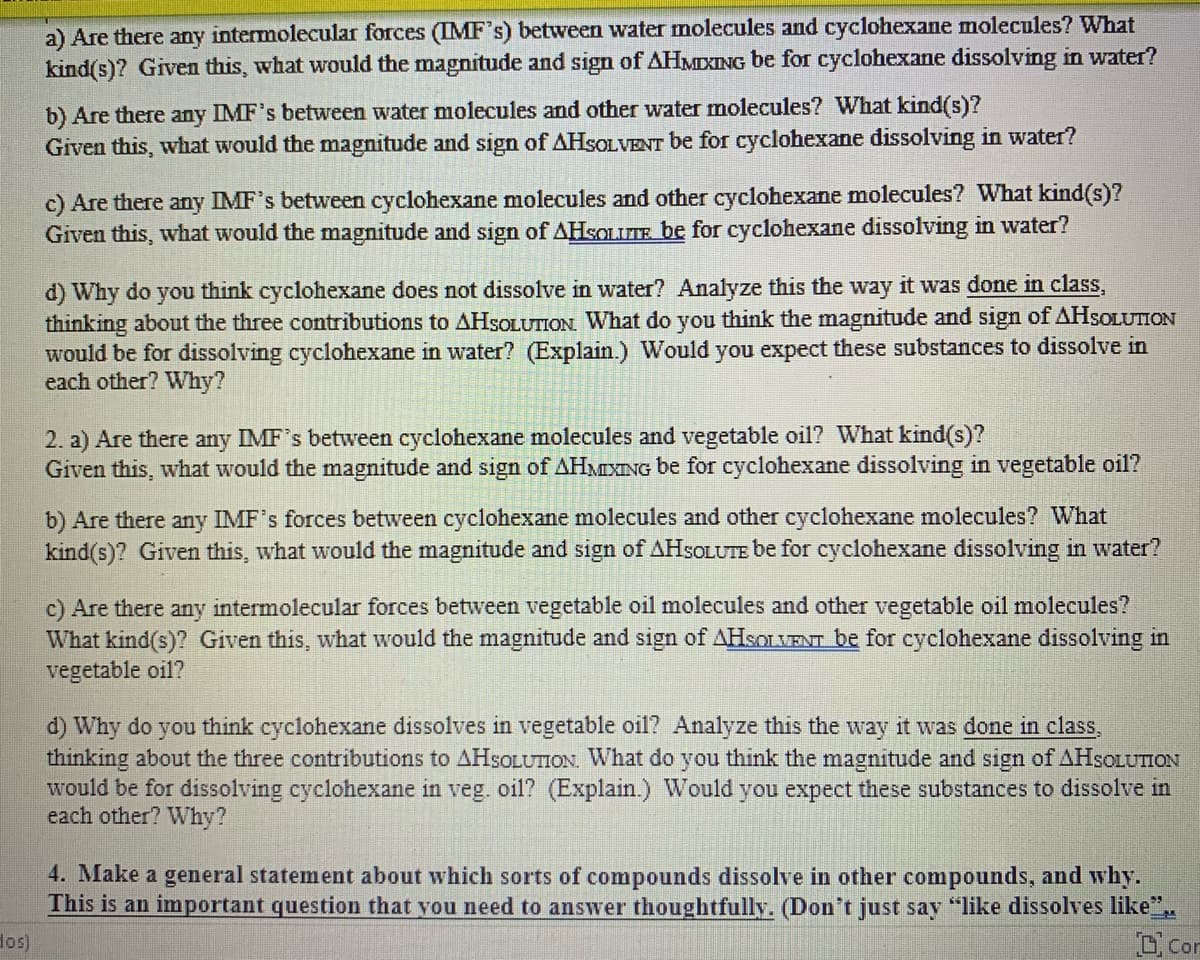a) Are there any intermolecular forces (IMF's) between water molecules and cyclohexane molecules? What kind(s)? Given this, what would the magnitude and sign of AHMIXING be for cyclohexane dissolving in water? b) Are there any IMF's between water molecules and other water molecules? What kind(s)? Given this, what would the magnitude and sign of AHSOLVENT be for cyclohexane dissolving in water? c) Are there any IMF's between cyclohexane molecules and other cyclohexane molecules? What kind(s)? Given this, what would the magnitude and sign of AHSOLITE be for cyclohexane dissolving in water?
a) Are there any intermolecular forces (IMF's) between water molecules and cyclohexane molecules? What kind(s)? Given this, what would the magnitude and sign of AHMIXING be for cyclohexane dissolving in water? b) Are there any IMF's between water molecules and other water molecules? What kind(s)? Given this, what would the magnitude and sign of AHSOLVENT be for cyclohexane dissolving in water? c) Are there any IMF's between cyclohexane molecules and other cyclohexane molecules? What kind(s)? Given this, what would the magnitude and sign of AHSOLITE be for cyclohexane dissolving in water?
Chemistry: The Molecular Science
5th Edition
ISBN:9781285199047
Author:John W. Moore, Conrad L. Stanitski
Publisher:John W. Moore, Conrad L. Stanitski
Chapter9: Liquids, Solids, And Materials
Section: Chapter Questions
Problem ISP
Related questions
Question

Transcribed Image Text:a) Are there any intermolecular forces (IMF's) between water molecules and cyclohexane molecules? What
kind(s)? Given this, what would the magnitude and sign of AHMIXING be for cyclohexane dissolving in water?
b) Are there any IMF's between water molecules and other water molecules? What kind(s)?
Given this, what would the magnitude and sign of AHSOLVENT be for cyclohexane dissolving in water?
c) Are there any IMF's between cyclohexane molecules and other cyclohexane molecules? What kind(s)?
Given this, what would the magnitude and sign of AHSOLITE be for cyclohexane dissolving in water?
d) Why do you think cyclohexane does not dissolve in water? Analyze this the way it was done in class,
thinking about the three contributions to AHSOLUTION. What do you think the magnitude and sign of AHSOLUTION
would be for dissolving cyclohexane in water? (Explain.) Would you expect these substances to dissolve in
each other? Why?
2. a) Are there any IMF's between cyclohexane molecules and vegetable oil? What kind(s)?
Given this, what would the magnitude and sign of AHMIXING be for cyclohexane dissolving in vegetable oil?
b) Are there any IMF's forces between cyclohexane molecules and other cyclohexane molecules? What
kind(s)? Given this, what would the magnitude and sign of AHSOLUTE be for cyclohexane dissolving in water?
c) Are there any intermolecular forces between vegetable oil molecules and other vegetable oil molecules?
What kind(s)? Given this, what would the magnitude and sign of AHSOLVENT be for cyclohexane dissolving in
vegetable oil?
d) Why do you think cyclohexane dissolves in vegetable oil? Analyze this the way it was done in class,
thinking about the three contributions to AHSOLUTION. What do you think the magnitude and sign of AHSOLUTION
would be for dissolving cyclohexane in veg. oil? (Explain.) Would you expect these substances to dissolve in
each other? Why?
4. Make a general statement about which sorts of compounds dissolve in other compounds, and why.
This is an important question that you need to answer thoughtfully. (Don't just say "like dissolves like".
D Con
dos)
Expert Solution
This question has been solved!
Explore an expertly crafted, step-by-step solution for a thorough understanding of key concepts.
This is a popular solution!
Trending now
This is a popular solution!
Step by step
Solved in 2 steps

Knowledge Booster
Learn more about
Need a deep-dive on the concept behind this application? Look no further. Learn more about this topic, chemistry and related others by exploring similar questions and additional content below.Recommended textbooks for you

Chemistry: The Molecular Science
Chemistry
ISBN:
9781285199047
Author:
John W. Moore, Conrad L. Stanitski
Publisher:
Cengage Learning

Chemistry: Principles and Practice
Chemistry
ISBN:
9780534420123
Author:
Daniel L. Reger, Scott R. Goode, David W. Ball, Edward Mercer
Publisher:
Cengage Learning

Introductory Chemistry: An Active Learning Approa…
Chemistry
ISBN:
9781305079250
Author:
Mark S. Cracolice, Ed Peters
Publisher:
Cengage Learning

Chemistry: The Molecular Science
Chemistry
ISBN:
9781285199047
Author:
John W. Moore, Conrad L. Stanitski
Publisher:
Cengage Learning

Chemistry: Principles and Practice
Chemistry
ISBN:
9780534420123
Author:
Daniel L. Reger, Scott R. Goode, David W. Ball, Edward Mercer
Publisher:
Cengage Learning

Introductory Chemistry: An Active Learning Approa…
Chemistry
ISBN:
9781305079250
Author:
Mark S. Cracolice, Ed Peters
Publisher:
Cengage Learning

Chemistry: An Atoms First Approach
Chemistry
ISBN:
9781305079243
Author:
Steven S. Zumdahl, Susan A. Zumdahl
Publisher:
Cengage Learning


Chemistry
Chemistry
ISBN:
9781305957404
Author:
Steven S. Zumdahl, Susan A. Zumdahl, Donald J. DeCoste
Publisher:
Cengage Learning